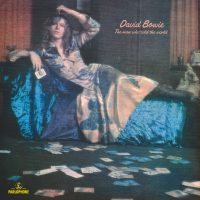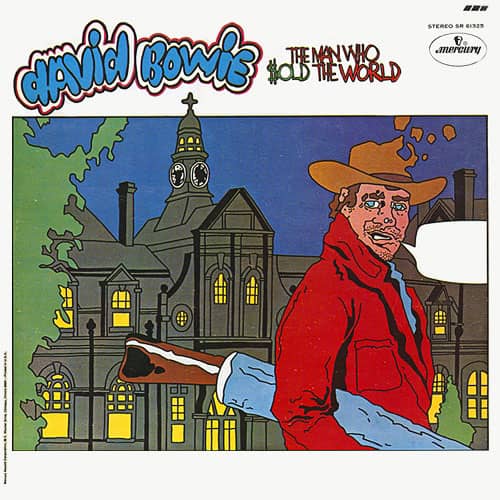 Written by: David Bowie
Written by: David Bowie
Recorded: 17 April – 22 May 1970
Producer: Tony Visconti
Engineers: Ken Scott, Gerald Chevin, Eddie Offord
Released: 8 April 1971 (UK); 4 November 1970 (US)
Available on:
The Man Who Sold The World
Glass Spider (Live Montreal ’87)
The Width Of A Circle
Personnel
David Bowie: vocals, acoustic guitarMick Ronson: electric guitar, recorder, vocals
Tony Visconti: bass guitar, recorder
Ralph Mace: Moog synthesizer
Mick ‘Woody’ Woodmansey: drums
The second song on David Bowie’s third album, ‘All The Madmen’ was written about his elder half-brother Terry Burns and his struggles with mental illness.
Who knows? Maybe I’m insane too, it runs in my family, but I always had a repulsive sort of need to be something more than human. I felt very very puny as a human. I thought. ‘Fuck that. I want to be a Superman.’ I guess I realized very early that man isn’t a very clever mechanism. I wanted to make myself better.
Rolling Stone, 12 February 1976
Burns was a key influence on the young Bowie, introducing him to jazz, new literature books and philosophical theories. He was, however, stricken with mental illness, and in 1967 suffered the first in a series of psychotic episodes.
I saw so little of him and I think I unconsciously exaggerated his importance. I invented this hero-worship to discharge my guilt and failure, and to set myself free from my own hang-ups.
BBC
By the time Bowie recorded The Man Who Sold The World, Burns was spending much of his time in a local asylum, Cane Hill. He visited Bowie often at weekends at Haddon Hall, and helped inspire several tracks on the album – ‘The Width Of A Circle’, ‘All The Madmen’, and the title track – along with later songs including ‘Five Years’, ‘The Bewlay Brothers’, and ‘Jump They Say’.
‘All The Madmen’ was written for my brother and it’s about my brother. He’s the man inside, and he doesn’t want to leave. He’s perfectly happy there – perfectly happy: Doesn’t have to work, just lies there on the lawn all day, looking at the sky. He’s very happy.He comes out occasionally. and we have him at home for a bit. But he gets in the way. He says ‘Well, I think I’ll go back to…” and he goes back, and we don’t see him for a few months. We go every fortnight, we go for the weekend and we take a hamper of sandwiches and apples and things, new shirts and fresh stuff, and take his laundry. And he’s always very happy to see us, but he never has anything to say.”
Phonograph Record, January 1972
Shortly after the release of The Man Who Sold The World, Bowie was interviewed by US journalist Patrick Salvo. The exchange touched upon Bowie’s relationship with Burns, and how ‘All The Madmen’ was written about him.
SALVO: This ‘growing up before one’s time’ can at times lead to any amount of various functional disorders.BOWIE: Yes, it does do.
SALVO: This is found quite plainly in some of your writings.
BOWIE: Yes, you’re right. It happened to my brother. Do you know the new album?
SALVO: The Man Who Sold The World.
BOWIE: There’s a track on that based on my brother, called ‘All The Madmen’.
SALVO: I heard he was in the hospital.
BOWIE: Yeah – in fact I just phoned up my wife and it seems he’s staying with us now. She wouldn’t tell me on the phone because he was in the room. I’m not sure whether he kinda ran away or what. He’s only 28, maybe 30. But, I mean there’s a schizoid streak within the family anyway so I dare say that I’m affected by that. The majority of the people in my family have been in some kind of mental institution, as for my brother he doesn’t want to leave. He likes it very much. He’s just been changed to a new one, but the old one, “Cain Hill,” he really dug. He’d be happy to spend the rest of his life there – mainly because most of the people are on the same wavelength as him. And he’s not a freak, he’s a very straight person.
SALVO: Did he walk in on his own two feet?
BOWIE: My mother signed him in, which is very sad, but she’s been in as well. She thought it did her good but it didn’t. We had to take her on holiday, we put her out in Cyprus for a bit. It’s getting very starchy.
Interview, March 1973
Mike Weller designed the original cover artwork for The Man Who Sold The World. Weller was in the year above Bowie at school, and was familiar with Cane Hill, which he depicted on the album sleeve.
To me the songs had expressed an undercurrent which was present in Croydon and Bromley, which is that he was singing about mental health problems. It was very much part of the surroundings. Every place has a ‘bogey’ aspect to it, and there it was Cane Hill because if you didn’t behave yourself that’s where you got told you were going to end up. We both knew people who had ended up as patients there. That’s where his brother Terry went. Even at school he would talk about Terry. I never met him, but it was him who introduced David to less conventional music, particularly jazz. It was that sort of place. Also, it was on a hill just outside Croydon, so it sort of loomed above you. And below… I think it had a connection with most people in the area at the time. In the 1980s you’d meet people had been sent there…In the late 1960s, my friend Gerald was committed to Cane Hill with schizophrenia and his parents were very concerned about him being sent there. DB was also very interested in the hospital and the treatment there – he attended an evening at Gerald’s house in Shortlands to discuss the kind of treatment that patients received at Cane Hill: aggressive treatments. Mrs Tyrell and Gerald’s sisters weren’t very happy with the kind of treatments he was receiving. He’d had shock treatment.
David Bowie: Ultimate Record Collection (Uncut)
Cane Hill was likely also immortalised in the song’s lyrics, as the “mansions cold and grey… where the thin men stalk the streets”. In 1971 Bowie gave an interview to American magazine Zygote. The magazine folded before the interview was published, but it was eventually posted online after Bowie’s death in 2016. In it he was asked about the songs on The Man Who Sold The World, including ‘All The Madmen’.
The guy in that story has been placed in a mental institution and there are a number of people in that institution being released each week that are his friends. Now they’ve said that he can leave as well. But he wants to stay there, ’cause he gets a lot more enjoyment out of staying there with the people he considers sane. He doesn’t want to go through the psychic compromises imposed on him by the outer world. [Pauses.] Ah, it’s my brother. ’Cause that’s where he’s at…What is David Bowie? David Bowie is the image, David Jones is me. But David Bowie is not a false person; I mean I am, also, David Bowie. I am schizoid. I’m as schizoid as my brother, except that I’m in the music business where I can get away with a lot more than my brother could get away with in the job that he had. I mean he was put into an institution for being like me. This is the fantastic quality of this business. Our level of standards of living is totally insane and absurd—to the civilian [laughs at the word] world. This army, it’s a pop army of madmen. The whole thing’s a symbolic army. I’m sure this is true, especially in England as we don’t have any more National Service, especially ’cause of this big virile blues kick that we’ve got going. Ah, it does feel like an army; I get a bit scared at times.
Zygote, 1971
There is an evident lift from the Beatles’ ‘You’ve Got To Hide Your Love Away’, with John Lennon’s “Here I stand, head in hand, turn my face to the wall” becoming “Here I stand, foot in hand, talking to my wall”. The repeated “Day after day” may also be a conscious echo of ‘The Fool On The Hill’.
Sex and drugs loom large in the lyrical melting pot. Bowie sings of how “it’s pointless to be high, ’cause it’s such a long way down”, of being grounded “as heavy as can be, just my librium and me”. Librium, or chlordiazepoxide, is a prescription benzodiazepine used to treat anxiety and alcohol withdrawal.
Bowie’s admission that “my libido’s split on me” also hints at his bisexuality, which he was exploring with increasing frequency in early 1970, not least in ‘The Width Of A Circle’.
At its core, however, is Bowie’s confession that “I’d rather play here with all the madmen/For I’m quite content they’re all as sane as me”. This intriguing payoff gives the impression that Bowie believed that everyone shared a tendency towards madness, and that state was the normality in which most people lived.
My brother Terry’s in an asylum right now. I’d like to believe that the insanity is because our family is all genius, but I’m afraid that’s not true. Some of them – a good many – are just nobodies. I’m quite fond of the insanity, actually. It’s a nice thing to throw out at parties, don’t you think? Everybody finds empathy in a nutty family. Everybody says, “Oh, yes, my family is quite mad.” Mine really is. No fucking about, boy. Most of them are nutty – in, just out of or going into an institution. Or dead.
Playboy, September 1976


